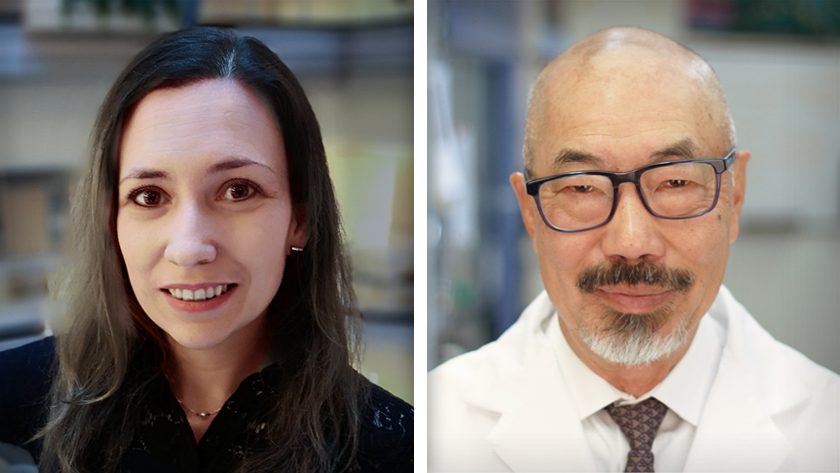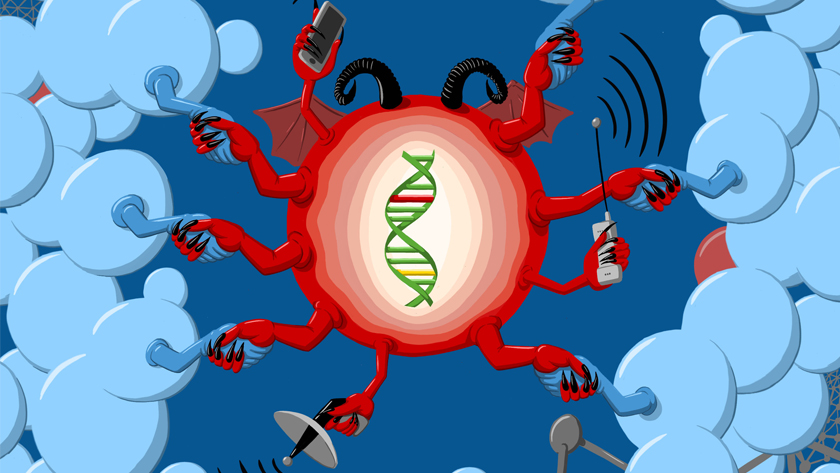
A team of researchers at the Princess Margaret Cancer Centre, co-led by Senior Scientist Dr. Tak Mak and postdoctoral researcher Dr. Julie Leca, have shed light on how two mutations found in a rare form of lymphoma—called angioimmunoblastic T cell lymphoma (AITL)—contribute to the disease. The work builds on a long history of collaboration with a group of researchers led by Drs. Philippe Gaulard and François Lemonnier in France.
AITL is a rare and aggressive form of cancer. The cancer originates in a particular type of cell known as a T follicular helper (Tfh) cell—a type of white blood cell that is part of the immune system. These cells play an essential role in protecting the body from foreign pathogens by supporting the production of antibodies in other immune cells called B cells.
AITL is known for having certain genetic mutations and a large tumour microenvironment—i.e., the area surrounding the tumour—that is made up of normal blood cells, blood vessels and other cellular components.
“One particular genetic mutation in the IDH2 gene is almost always present with another in the TET2 gene in AITL,” says Dr. Leca. “The co-existence of TET2 and IDH2 mutations in AITL is an intriguing feature, since in other blood cancers, such as acute myeloid leukemia, the mutations are mutually exclusive.”
Working together, the two groups described the IDH2 and TET2 mutations in AITL 10 years ago; however, how the IDH2 mutation contributes to AITL or how the two mutations cooperate during the development of the disease is not fully understood.
To solve this, the team developed experimental models of AITL with IDH2 and TET2 mutations. The researchers discovered that these mutations affect how Tfh cells function and how they interact with the tumour microenvironment, particularly with B cells.
They found that Tfh cells with these two mutations have altered gene expression and were better at promoting the growth and survival of B cells. Also, tumours with the mutations had higher levels of blood vessels and immune cells that make antibodies—two hallmarks that are seen in individuals with AITL.
“These findings provide insight on how these two mutations play a role in altering the interaction between Tfh cells and nearby cells,” says Dr. Mak. “But more importantly, they provide a rationale for exploiting these interactions as a potential treatment for AITL, which tends to be resistant to chemotherapy and displays poor clinical outcomes.”
This work was supported by the Leukemia & Lymphoma Society, the Canadian Institutes of Health Research, the Cancer Research Institute (US), the Fondation ARC pour la Recherche sur le Cancer, and The Princess Margaret Cancer Foundation. Dr. Tak Mak is a Professor in the Department of Medical Biophysics at the University of Toronto.
A. Melnick has consulted for Epizyme, Constellation, Daiichi Sankyo, AstraZeneca, 634 BMS, Janssen and ExoTherapeutics. He holds research funding from Epizyme, Janssen, Daiichi Sankyo and AstraZeneca; and is on the advisory board of KDAC Therapeutics. C. E. Mason is a cofounder and board member for Biotia and Onegevity Health and an advisor or grantee for Abbvie, ArcBio, Daiichi Sankyo, DNA Genotek, Tempus Labs and Whole Biome. T. W. Mak holds equity in Treadwell Therapeutics Inc. and Agios Pharmaceuticals, and is a consultant for AstraZeneca and Tessa Therapeutics.
Leca J*, Lemonnier F, Meydan C#, Foox J#, El Ghamrasni, Mboumba D-L, Duncan GS, Fortin J, Sakamoto T, Tobin C, Hodgson K, Haight J, Smith LK, Elia AJ, Butler D, Berger T, de Leval L, Mason CE, Melnick A, Gaulard P, Mak TW*. IDH2 and TET2 mutations synergize to modulate T follicular helper cell functional interaction with the angioimmunoblastic T cell lymphoma microenvironment. Cancer Cell. 2023 Feb. DOI: 10.1016/j.ccell.2023.01.003. *corresponding authors; #contributed equally

A cancerous Tfh cell, depicted in this illustration as a devil, alters its surrounding microenvironment in AITL. The two mutations (red and yellow DNA) change how the cancer cell interacts and communicates with normal cells through direct interaction and secreted molecules (depicted by hand shaking, and cellphone and antenna, respectively). Illustration by Sylvain Bagni. Conceptual visualization by Julie Leca and Tak Wah Mak.




